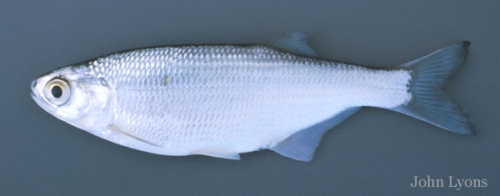Plants and Animals
Hiodon tergisus Mooneye
Key Characteristics
The mooneye is a laterally compressed, deep-bodied fish with a small oblique mouth and large eye. This silver fish has a keeled, but not serrate, ventral edge from pelvic fins to the anus.
Status and Rank
US Status: No Status/Not Listed
State Status: E - Endangered (legally protected)
Global Rank: G5 - Secure
State Rank: S1 - Critically imperiled
Occurrences
| County | Number of Occurrences | Year Last Observed |
|---|---|---|
| Allegan | 1 | 1941 |
| Delta | 1 | 1938 |
| Macomb | 3 | 2016 |
| Presque Isle | 1 | 1943 |
| St. Clair | 2 | 2007 |
| Wayne | 1 | 2012 |
Information is summarized from MNFI's database of rare species and community occurrences. Data may not reflect true distribution since much of the state has not been thoroughly surveyed.
Habitat
The mooneye occurs in clear large rivers and lakes. They are often found in deep holes of rivers with swift currents and firm substrates. In the Great Lakes they often occur within 1 mile of shoreline and are absent at depths below 10 m.
Specific Habitat Needs
Hard substrates needed in: Mainstem stream (3rd-4th order), pool; Mainstem stream (3rd-4th order), riffle; River (5th-6th order), pool; River (5th-6th order), run; River (5th-6th order), riffle;
Hard sustrates needed in: Mainstem stream (3rd-4th order), run;
Natural Community Types
- Inland lake, pelagic, midwater
- Mainstem stream (3rd-4th order), pool
- Mainstem stream (3rd-4th order), run
- Mainstem stream (3rd-4th order), riffle
- River (5th-6th order), pool
- River (5th-6th order), run
- River (5th-6th order), riffle
For each species, lists of natural communities were derived from review of the nearly 6,500 element occurrences in the MNFI database, in addition to herbarium label data for some taxa. In most cases, at least one specimen record exists for each listed natural community. For certain taxa, especially poorly collected or extirpated species of prairie and savanna habitats, natural community lists were derived from inferences from collection sites and habitat preferences in immediately adjacent states (particularly Indiana and Illinois). Natural communities are not listed for those species documented only from altered or ruderal habitats in Michigan, especially for taxa that occur in a variety of habitats outside of the state.
Natural communities are not listed in order of frequency of occurrence, but are rather derived from the full set of natural communities, organized by Ecological Group. In many cases, the general habitat descriptions should provide greater clarity and direction to the surveyor. In future versions of the Rare Species Explorer, we hope to incorporate natural community fidelity ranks for each taxon.
Management Recommendations
Local populations are highly susceptible to extinction because losses due to natural or human-induced perturbations cannot be replaced by neighboring populations. The mooneye is intolerant of silt and turbidity, and as such agricultural, urbanization, and industrialization practices can be detrimental to this species. Declines have also been attributed to increasing pollution.
Active Period
Spawning from first week of April to fourth week of June
Survey Methods
Electrofishing
Survey Period: From first week of April to fourth week of October
Gill nets
Survey Period: From first week of April to fourth week of October
Trawls
Survey Period: From first week of April to fourth week of October
References
Survey References
- Murphy, B.R. and D.W. Willis, eds. 1996. Fisheries Techniques, 2nd ed. American Fisheries Society, Bethesda. 732pp.
Technical References
- Bailey, R.M., W.C. Latta, and G.R. Smith. 2004. An Atlas of Michigan Fishes. Museum of Zoology, University of Michigan, No. 192, Ann Arbor. 215p.
- Derosier, A.L. 2004. Special Animal Abstract for Hidon tergisus (Mooneye). Michigan Natural Features Inventory, Lansing, MI. 3pp.
- Evers, D.C. 1994. Endangered and Threatened Wildlife of Michigan. The University of Michigan Press, Ann Arbor. 412pp.
- Smith, P. W. 1979. The Fishes of Illinois. University of Illinois Press, Chicago. 314 pp.
- Trautman, M.B. 1981. The Fishes of Ohio. Ohio State University Press, Columbus. 782pp.


